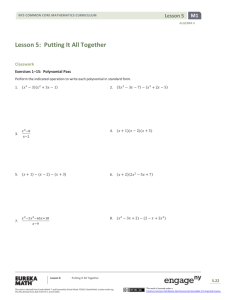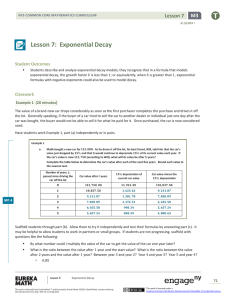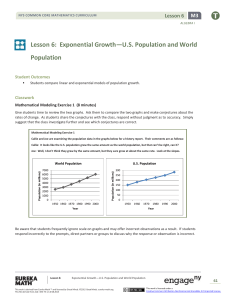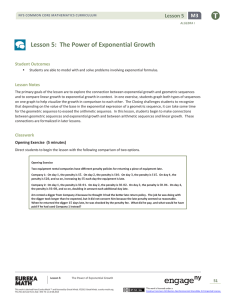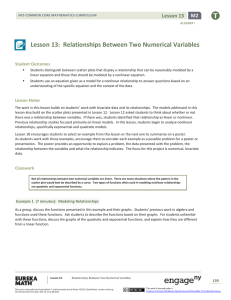Algebra I Module 3, Topic A, Lesson 7: Student Version
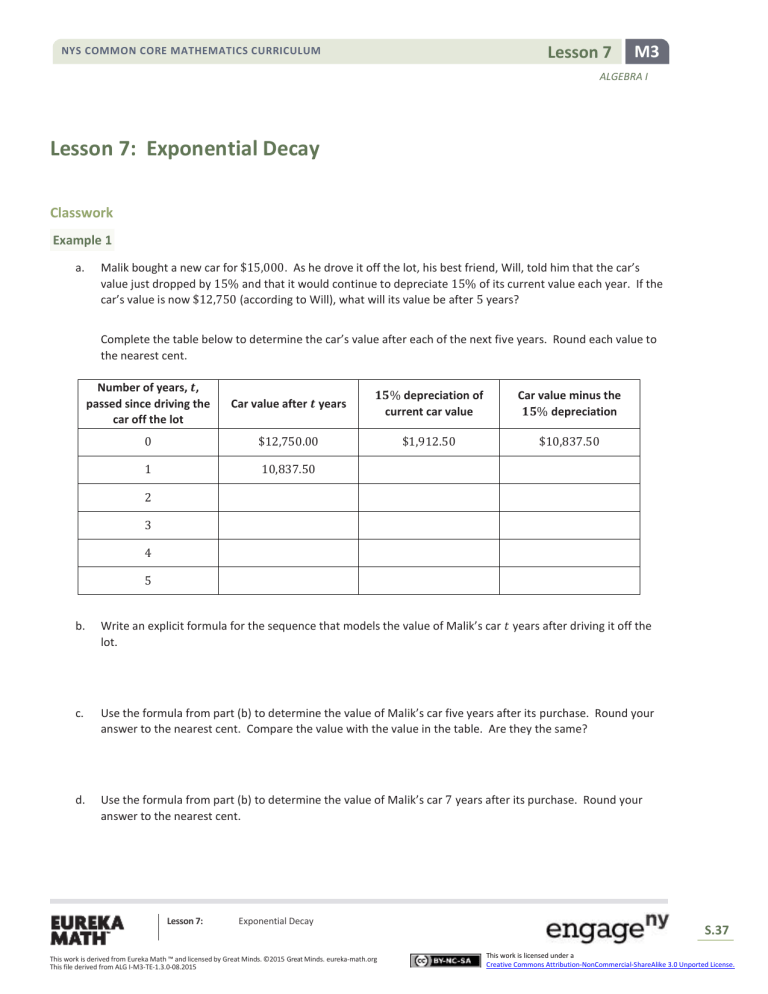
NYS COMMON CORE MATHEMATICS CURRICULUM
Lesson 7: Exponential Decay
Lesson 7 M3
ALGEBRA I
Classwork
Example 1 a.
Malik bought a new car for $15,000 . As he drove it off the lot, his best friend, Will, told him that the car’s value just dropped by 15% and that it would continue to depreciate 15% of its current value each year. If the car’s value is now $12,750 (according to Will), what will its value be after 5 years?
Complete the table below to determine the car’s value after each of the next five years. Round each value to the nearest cent.
Number of years, 𝒕 , passed since driving the car off the lot
0
1
2
Car value after 𝒕 years
$12,750.00
10,837.50
𝟏𝟓% depreciation of current car value
$1,912.50
Car value minus the
𝟏𝟓% depreciation
$10,837.50
3
4
5 b.
Write an explicit formula for the sequence that models the value of Malik’s car 𝑡 years after driving it off the lot. c.
Use the formula from part (b) to determine the value of Malik’s car five years after its purchase. Round your answer to the nearest cent. Compare the value with the value in the table. Are they the same? d.
Use the formula from part (b) to determine the value of Malik’s car 7 years after its purchase. Round your answer to the nearest cent.
Lesson 7: Exponential Decay
This work is derived from Eureka Math ™ and licensed by Great Minds. ©2015 Great Minds. eureka-math.org
This file derived from ALG I-M3-TE-1.3.0-08.2015
S.37
This work is licensed under a
Creative Commons Attribution-NonCommercial-ShareAlike 3.0 Unported License.
NYS COMMON CORE MATHEMATICS CURRICULUM
Exercises 1–6
Lesson 7 M3
ALGEBRA I
1.
Identify the initial value in each formula below, and state whether the formula models exponential growth or exponential decay. Justify your responses. a.
𝑓(𝑡) = 2 (
2
5
) 𝑡 b.
𝑓(𝑡) = 2 (
5
3
) 𝑡 c.
𝑓(𝑡) =
2
3
(3) 𝑡 d.
𝑓(𝑡) =
2
3
(
1
3
) 𝑡 e.
𝑓(𝑡) =
3
2
(
2
3
) 𝑡
2.
If a person takes a given dosage 𝑑 of a particular medication, then the formula 𝑓(𝑡) = 𝑑 (0.8) 𝑡 represents the concentration of the medication in the bloodstream 𝑡 hours later. If Charlotte takes 200 mg of the medication at
6: 00 a.m., how much remains in her bloodstream at 10: 00 a.m.? How long does it take for the concentration to drop below 1 mg ?
Lesson 7: Exponential Decay
This work is derived from Eureka Math ™ and licensed by Great Minds. ©2015 Great Minds. eureka-math.org
This file derived from ALG I-M3-TE-1.3.0-08.2015
S.38
This work is licensed under a
Creative Commons Attribution-NonCommercial-ShareAlike 3.0 Unported License.
NYS COMMON CORE MATHEMATICS CURRICULUM Lesson 7 M3
ALGEBRA I
3.
When you breathe normally, about 12% of the air in your lungs is replaced with each breath. Write an explicit formula for the sequence that models the amount of the original air left in your lungs, given that the initial volume of air is 500 ml . Use your model to determine how much of the original 500 ml remains after 50 breaths.
4.
Ryan bought a new computer for $2,100 . The value of the computer decreases by 50% each year. When will the value drop below $300 ?
5.
Kelli’s mom takes a 400 mg dose of aspirin. Each hour, the amount of aspirin in a person’s system decreases by about 29% . How much aspirin is left in her system after 6 hours?
6.
According to the International Basketball Association (FIBA), a basketball must be inflated to a pressure such that when it is dropped from a height of 1,800 mm , it rebounds to a height of 1,300 mm . Maddie decides to test the rebound-ability of her new basketball. She assumes that the ratio of each rebound height to the previous rebound height remains the same at
1300
1800
. Let 𝑓(𝑛) be the height of the basketball after 𝑛 bounces. Complete the chart below to reflect the heights Maddie expects to measure.
1
2
3
4 𝒏
0 𝒇(𝒏)
1,800
Lesson 7: Exponential Decay
This work is derived from Eureka Math ™ and licensed by Great Minds. ©2015 Great Minds. eureka-math.org
This file derived from ALG I-M3-TE-1.3.0-08.2015
S.39
This work is licensed under a
Creative Commons Attribution-NonCommercial-ShareAlike 3.0 Unported License.
NYS COMMON CORE MATHEMATICS CURRICULUM Lesson 7 M3
ALGEBRA I a.
Write the explicit formula for the sequence that models the height of Maddie’s basketball after any number of bounces. b.
Plot the points from the table. Connect the points with a smooth curve, and then use the curve to estimate the bounce number at which the rebound height drops below 200 mm .
2000
1800
1600
1400
1200
1000
800
600
400
200
0
0 1 2 3 4 5 6
Number of bounces, n
7 8 9 10
Lesson 7: Exponential Decay
This work is derived from Eureka Math ™ and licensed by Great Minds. ©2015 Great Minds. eureka-math.org
This file derived from ALG I-M3-TE-1.3.0-08.2015
S.40
This work is licensed under a
Creative Commons Attribution-NonCommercial-ShareAlike 3.0 Unported License.
NYS COMMON CORE MATHEMATICS CURRICULUM Lesson 7 M3
ALGEBRA I
Lesson Summary
The explicit formula 𝑓(𝑡) = 𝑎𝑏 𝑡 models exponential decay, where 𝑎 represents the initial value of the sequence, 𝑏 < 1 represents the growth factor (or decay factor) per unit of time, and 𝑡 represents units of time.
Problem Set
1.
From 2000 to 2013, the value of the U.S. dollar has been shrinking. The value of the U.S. dollar over time ( 𝑣(𝑡) ) can be modeled by the following formula: 𝑣(𝑡) = 1.36(0.9758) 𝑡
, where 𝑡 is the number of years since 2000 a.
How much was a dollar worth in the year 2005? b.
Graph the points (𝑡, 𝑣(𝑡)) for integer values of 0 ≤ 𝑡 ≤ 14 . c.
Estimate the year in which the value of the dollar fell below $1.00
.
2.
A construction company purchased some equipment costing $300,000 . The value of the equipment depreciates
(decreases) at a rate of 14% per year. a.
Write a formula that models the value of the equipment each year. b.
What is the value of the equipment after 9 years? c.
Graph the points (𝑡, 𝑣(𝑡)) for integer values of 0 ≤ 𝑡 ≤ 15 . d.
Estimate when the equipment will have a value of $50,000 .
3.
The number of newly reported cases of HIV (in thousands) in the United States from 2000 to 2010 can be modeled by the following formula: 𝑓(𝑡) = 41(0.9842) 𝑡
, where 𝑡 is the number of years after 2000 a.
Identify the growth factor. b.
Calculate the estimated number of new HIV cases reported in 2004. c.
Graph the points (𝑡, 𝑓(𝑡)) for integer values of 0 ≤ 𝑡 ≤ 10 . d.
During what year did the number of newly reported HIV cases drop below 36,000 ?
4.
Doug drank a soda with 130 mg of caffeine. Each hour, the caffeine in the body diminishes by about 12% . a.
Write a formula to model the amount of caffeine remaining in Doug’s system each hour. b.
How much caffeine remains in Doug’s system after 2 hours? c.
How long will it take for the level of caffeine in Doug’s system to drop below 50 mg ?
Lesson 7: Exponential Decay
This work is derived from Eureka Math ™ and licensed by Great Minds. ©2015 Great Minds. eureka-math.org
This file derived from ALG I-M3-TE-1.3.0-08.2015
S.41
This work is licensed under a
Creative Commons Attribution-NonCommercial-ShareAlike 3.0 Unported License.
NYS COMMON CORE MATHEMATICS CURRICULUM Lesson 7
5.
64 teams participate in a softball tournament in which half the teams are eliminated after each round of play.
M3
ALGEBRA I a.
Write a formula to model the number of teams remaining after any given round of play. b.
How many teams remain in play after 3 rounds? c.
How many rounds of play will it take to determine which team wins the tournament?
6.
Sam bought a used car for $8,000 . He boasted that he got a great deal since the value of the car two years ago
(when it was new) was $15,000 . His friend, Derek, was skeptical, stating that the value of a car typically depreciates about 25% per year, so Sam got a bad deal. a.
Use Derek’s logic to write a formula for the value of Sam’s car. Use 𝑡 for the total age of the car in years. b.
Who is right, Sam or Derek?
Lesson 7: Exponential Decay
This work is derived from Eureka Math ™ and licensed by Great Minds. ©2015 Great Minds. eureka-math.org
This file derived from ALG I-M3-TE-1.3.0-08.2015
S.42
This work is licensed under a
Creative Commons Attribution-NonCommercial-ShareAlike 3.0 Unported License.









